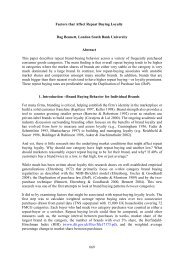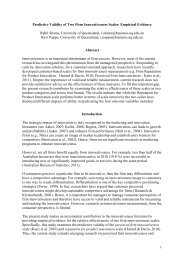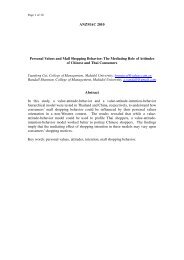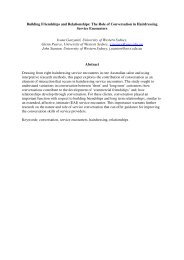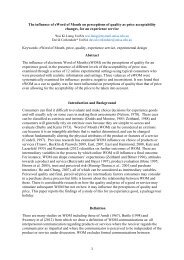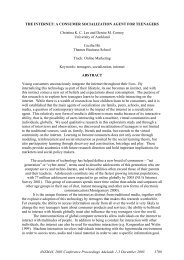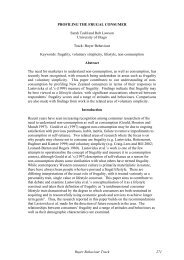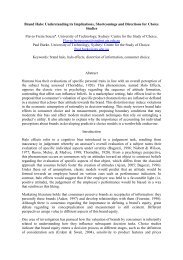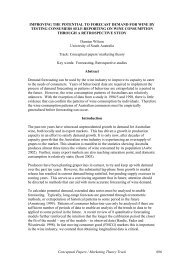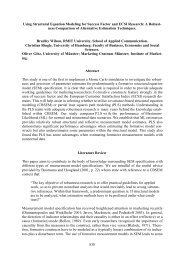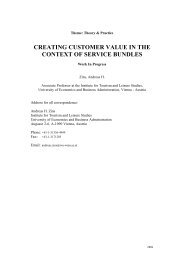A CONCEPTUAL MODEL OF TOURISM DESTINATION ...
A CONCEPTUAL MODEL OF TOURISM DESTINATION ...
A CONCEPTUAL MODEL OF TOURISM DESTINATION ...
You also want an ePaper? Increase the reach of your titles
YUMPU automatically turns print PDFs into web optimized ePapers that Google loves.
Political violence has affected tourism the world over, for example Egypt, Israel, and<br />
Peru where political instability adversely affected tourist perceptions of these<br />
destinations. Safety concerns causes a decline in tourist arrivals, reduce tourists<br />
expenditures and can cause a downturn in local travel. The safety and security of a<br />
destination therefore plays a role in determining the level of attractiveness.<br />
The competitive advantage and collaborative advantage paradigms have dominated<br />
management and marketing theory, research and practice as alternatives. The<br />
competitive advantage enables a firm to compete and perform better than competition<br />
(Day and Wensley 1988; Porter 1985). The alternative model, the<br />
collaborative/cooperative model enables firms to enhance their performance through<br />
strategic collaboration (Contractor and Lorange 1988; Neilsen 1987).<br />
Various actions have been debated about how firms can compete and corresponding<br />
strategies put forward. For instance product/service innovations, entry barriers,<br />
marketing and promotion campaigns and competitive rivalry among others, have been<br />
identified as drivers of competition in an industry. Early economists suggested that<br />
competition in an industry is ruinous (Jones 1920) especially if it is solely based on<br />
price. Extending this view, competition within a destination can be ruinous if it is<br />
solely based on price-cutting.<br />
The advantages that cooperative agreements provide for organisations have been well<br />
documented. Close relationships with suppliers and customers can provide firms with<br />
a very important source of innovation, costs reduction (Hagen and Soonkyoo 1998;<br />
Ring and Van de ven 1992). Lado, Boyd and Hanlon (1997) suggest that<br />
organisations can enhance their performance through competition and cooperation<br />
simultaneously. They argue that for firms to enhance their competitiveness they need<br />
to “adopt a repertoires of behaviour that support cooperation and trust” (pg 111).<br />
Thus cooperation can enhance the competitiveness of an organisation, for example<br />
Toyota’s cooperation with its suppliers and the cooperation between Ford and Mazda.<br />
In their Syncretic Model, Lado, Boyd and Hanlon (1997) proposed that organisations<br />
could generate long-term performance by simultaneously competing and cooperation.<br />
Striking a balance between competition and cooperation is vital to the performance<br />
and survival of organisations (Jorde and Teece 1989). Firms within a destination need<br />
to cooperate and compete against other destination.<br />
The destination environment is the most important factor in TDCA. The components<br />
of the destination environment can either enhance or destroy the destination. As an<br />
experience product, tourists requires an environment that is safe, with employees that<br />
are customer and service focussed, enhanced by close cooperation by businesses<br />
within the destination. A conducive destination environment is vital for visitors to<br />
enjoy and be satisfied with the tourist experience. This leads us to Propositions 3 and<br />
4:<br />
P3. The destination environment composed of crowding, safety, skilled human<br />
resources and the level of cooperation and competition within the destination.<br />
P4. The environment in which tourist product is experienced, is related to the<br />
attractiveness and competitiveness of destinations.<br />
Communication and Promotion<br />
Branding of destinations enable tourists to identify a destination and differentiate it<br />
from competitive offerings. Destination branding also acts as a cue for the<br />
communication of benefits to the tourist. The brand acts as a shorthand device for<br />
communicating functional and emotional benefits (de Chernatony and McDonald<br />
1998). As such, it can quicken the destination choice decision process. Branding<br />
Conceptual Papers / Marketing Theory Track 642



